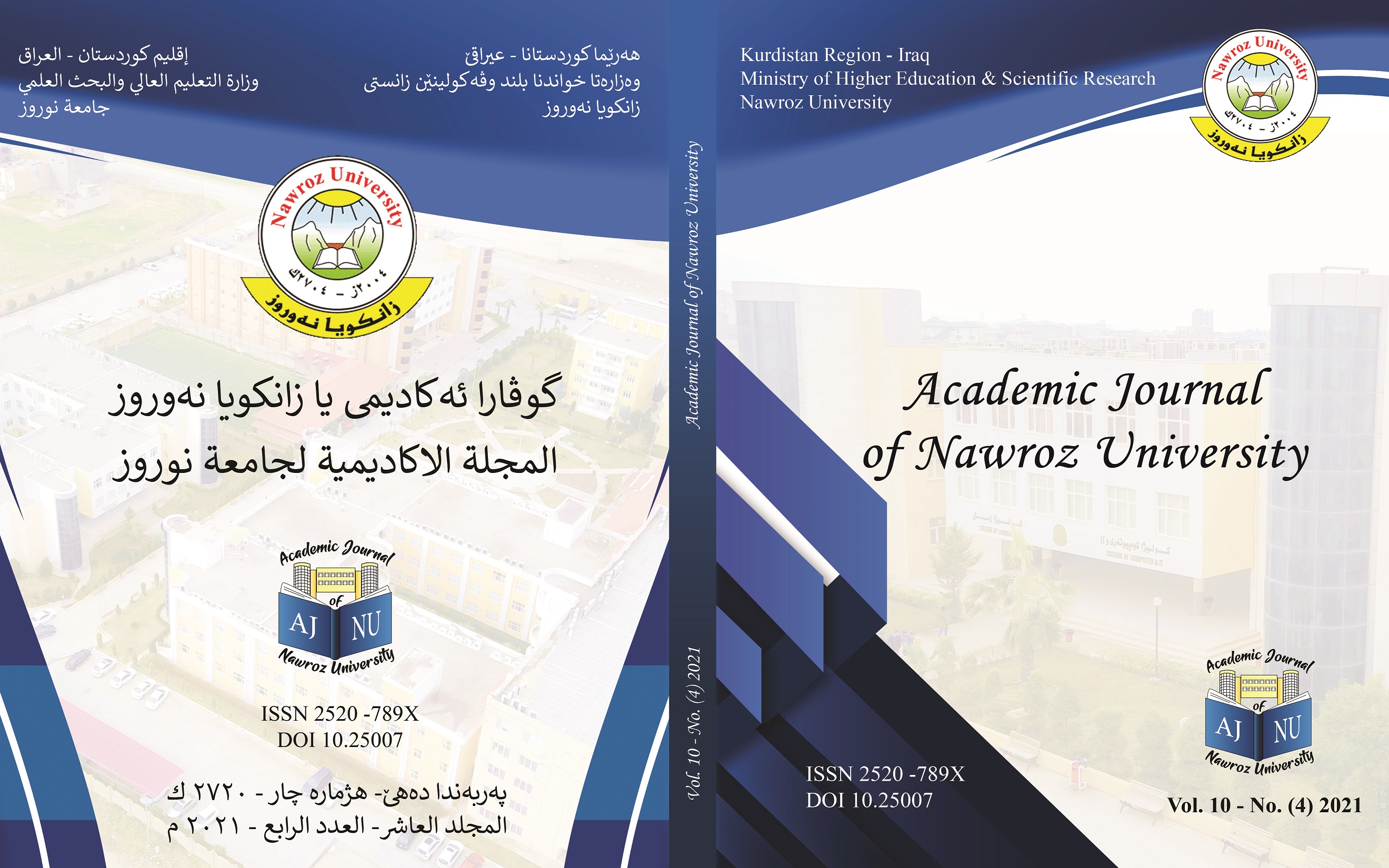Spoken Grammar: Meaning, Principles and Characteristics
DOI:
https://doi.org/10.25007/ajnu.v10n4a1187Keywords:
Spoken Grammar, Written Grammar, Conversational spoken English, Grammatical rulesAbstract
Abstract
The terms Spoken Grammar was coined by the two corpus grammarians, Ronald Carter and Mike McCarthy. In the 19th century, it came under the impact of a number of local dialects represented by the cockney dialect in London, and the Lothian dialect in Edinburgh. The discussions, debates and studies on Spoken grammar have led to the specification of three main viewpoints concerning the existence of this types of grammar. The viewpoints entail that (1) grammatical rules do not govern spoken language, which is disorderly and disordered; (2) Speaking English lacks a distinct grammar. It has the same syntax as written English grammar; and (3) spoken language is regulated by a separate grammar with its own set of rules and conventions; i.e. it has its own grammar represented by its own set of rules, regulations, and classifications compared to those of the written language. T validate or refute the implications of the preceding viewpoints, relevant literature concludes that spoken grammar is quite prevalent in everyday conversational spoken English. It is characterized by being more flexible and less strict compared to written grammar. This is so because the informal context of using spoken grammar makes it have a syntax that varies from the traditional written grammar in a number of aspects. This purely theoretical research aims at shedding light on the definition, meaning, principles and the main characteristics of spoken grammar. The emphasis on the distinctive features of spoken grammar has triggered the researchers to focus on a further point of discussion, namely the differences between spoken and written grammar. To substantiate such differences, examples from closely relevant grammatical literature have also been provided. The research ends with some concluding points drawn upon from the preceding discussed and presented points.
Downloads
References
References
Baron, N. S. (2000). Alphabet to Email: How Written English Evolved and Where It's Heading. New York: Routledge.
Biber, D., Johansson, S., Leech G., Conrad, S., and Finegan, E. (1999). Longman Grammar of Spoken and Written English. London: Longman.
Brown, G. and Yule, G. (1983). Discourse Analysis. Cambridge: Cambridge University Press.
Carter, R. and McCarthy, M. (1995). Grammar and the spoken language. Applied Linguistics, 16, 141-158.
Carter, R. and Mcarthy, M. (2006). Cambridge Grammar of English: A Comprehensive Guide. (1st ed.). Cambridge: CUP.
Cheshire, J. (1999). "Spoken Standard English", Standard English: The Widening Debate, ed. by Tony Bex and Richard J. Watts. New York: Routledge,
Crystal, D. (2003). The Cambridge Encyclopedia of the English Language, (2nd ed.). Cambridge: Cambridge University Press.
Emerson, O. F. (1896). The Teaching of English Grammar.
Goh, C. (2009). “Perspectives on spoken grammar”. ELT Journal 63 (4): 303–312.
Hird, J. ( 2016). It’s different, spoken grammar. Oxford: Oxford University Press ELT
Paterson, K. (2019). “9 thoughts on “It’s different, spoken grammar”, Grammar Fiction. Oxford: Oxford University Press.
Leech, G. (2000). Grammars of spoken English: New outcomes of corpus-oriented research. Language Learning, 50 (4): 675–724.
Mumford, S. (2009). An analysis of spoken grammar: The case for production. ELT Journal 63 (2): 137–144.
TESOL (2003). Designing Natural Spoken English Courses. Spain: Valencia..
The Cambridge International Corpus (CIC)*).
Timmis, I. (2005). Towards a framework for teaching spoken grammar. ELT Journal 59 (2): 117–125.
Usó-Juan, E. and Martínez-Flor, A. (2008). Teaching learners to appropriately mitigate requests. ELT Journal, 62(4), 349-357.
Zhou, Q. (2006). Application of a discourse approach to speaking in teaching of conversation. US-China Education Review, 3(3), 57-63.
Downloads
Published
How to Cite
Issue
Section
License
Copyright (c) 2022 Ru’a Salim Mahmood, Hussein Ali Ahmed

This work is licensed under a Creative Commons Attribution-NonCommercial-NoDerivatives 4.0 International License.
Authors retain copyright
The use of a Creative Commons License enables authors/editors to retain copyright to their work. Publications can be reused and redistributed as long as the original author is correctly attributed.
- Copyright
- The researcher(s), whether a single or joint research paper, must sell and transfer to the publisher (the Academic Journal of Nawroz University) through all the duration of the publication which starts from the date of entering this Agreement into force, the exclusive rights of the research paper/article. These rights include the translation, reuse of papers/articles, transmit or distribute, or use the material or parts(s) contained therein to be published in scientific, academic, technical, professional journals or any other periodicals including any other works derived from them, all over the world, in English and Arabic, whether in print or in electronic edition of such journals and periodicals in all types of media or formats now or that may exist in the future. Rights also include giving license (or granting permission) to a third party to use the materials and any other works derived from them and publish them in such journals and periodicals all over the world. Transfer right under this Agreement includes the right to modify such materials to be used with computer systems and software, or to reproduce or publish it in e-formats and also to incorporate them into retrieval systems.
- Reproduction, reference, transmission, distribution or any other use of the content, or any parts of the subjects included in that content in any manner permitted by this Agreement, must be accompanied by mentioning the source which is (the Academic Journal of Nawroz University) and the publisher in addition to the title of the article, the name of the author (or co-authors), journal’s name, volume or issue, publisher's copyright, and publication year.
- The Academic Journal of Nawroz University reserves all rights to publish research papers/articles issued under a “Creative Commons License (CC BY-NC-ND 4.0) which permits unrestricted use, distribution, and reproduction of the paper/article by any means, provided that the original work is correctly cited.
- Reservation of Rights
The researcher(s) preserves all intellectual property rights (except for the one transferred to the publisher under this Agreement).
- Researcher’s guarantee
The researcher(s) hereby guarantees that the content of the paper/article is original. It has been submitted only to the Academic Journal of Nawroz University and has not been previously published by any other party.
In the event that the paper/article is written jointly with other researchers, the researcher guarantees that he/she has informed the other co-authors about the terms of this agreement, as well as obtaining their signature or written permission to sign on their behalf.
The author further guarantees:
- The research paper/article does not contain any defamatory statements or illegal comments.
- The research paper/article does not violate other's rights (including but not limited to copyright, patent, and trademark rights).
This research paper/article does not contain any facts or instructions that could cause damages or harm to others, and publishing it does not lead to disclosure of any confidential information.





